Featured Graduate Researchers

2018 EDGE Award Recipient
Bridget Lee, Ph.D. Candidate in Earth Sciences
Patagonia: Southernmost South America Iron(Fe) flux and its significance to Southern Ocean (SO) Paleoclimate
Climatic records from southernmost South America are critical cornerstones to link Antarctic paleoclimatic archives with global climate. Ongoing debates over the sensitivity of global carbon cycle driven by iron (Fe) bioavailability in Southern Ocean are the center of studies to understand the global climate system. The dynamics of the Southern Ocean (SO) have a global impact on primary productivity, biodiversity and the associated feedback mechanisms for carbon and biogeochemical cycling (Arrigo et al., 2008; Moore et al., 2013; Watson et al., 2000). This project aims to characterize iron (Fe) and aeolian dust flux during the Hypsithermal period (Holocene climatic optimum-Milankovitch solar maximum) (ca. 9–6 cal. ka) using sediment cores from Lago Cardiel located on the Patagonian Plateau and Lago Fagnano from the southern part of the island of Tierra del Fuego, Argentina. The overarching motivation of this study is a quantitative climatic and environmental reconstruction of aeolian iron (Fe) and its mechanisms behind climate change in southernmost Patagonia that plays an important role in global biogeochemical cycle.
Urban greenspaces, such as parks and the urban forest, act as conduits providing a sense of connection to natural processes, which then encourage people to support conservation of wildlands. 1. However, these conduits can only function if city residents are using them. If urban areas grow hotter through the feedback of global climate change and urban heat island effects, there is a risk that individuals will abstain from outdoor urban activities, thus losing a connection to nature. Through my research I highlight urban green spaces as ways to mitigate heat and act as a cool oasis against urban heat, as well as exploring various mechanisms of air cooling. While urban landscape ecologists have long used satellite remote sensing at a tool to study heat within urban areas, there has often been a significant aspect left out of their models and data 2. Satellite technology is very useful about describing the thermal conditions of land surfaces (LST), however it does very little in elucidating the air temperature (T air ) near the surface 3. Near-surface air temperature represents the weather conditions that people are actually experiencing in cities 4. When heat warnings are sent out, they are in reference to thermal equations describing the near surface conditions. My research combines in-situ near surface metrics of thermal comfort with NASA’s Landsat 8 satellite surface temperature and vegetation to explore both the drivers of urban cooling as well as specific locations of cool areas. The multidisciplinary goals of UCR’s EDGE Institute, along with its commitment to examine the current issues of environmental change across social and geographical scales is a fantastic home to present my current work.

2018 EDGE Award Recipient
Kaleigh Russell, Ph.D. Candidate in Entomology
The effects of climate change on plants, pollinators, and their microbial symbionts
The impact that climate change will have on our world is of immense importance. Scientists have seen rapid environmental change over the past century, specifically, global surface temperature has increased almost 2°C over the past century. Fifteen of the hottest years on record have been between the years 2000-2017, 2017 being the hottest year ever recorded. An increase in environmental temperature has the potential to disrupt important evolutionary interactions. Importantly, plant-pollinator interactions are very sensitive to temperature stress and can interrupted. Insect facilitated pollination contributes to roughly 1/3 of crop production. Honey bees are managed pollinators that perform most of agricultural pollination. Honey bee and wild bee populations are in decline due to pesticide use, loss of habitat, parasites and pathogens, and climate change. It is imperative that we understand how climate change will affect the way plants and pollinators interact. Pollinator networks include not only the plant and animal involved, but also microorganisms- or microbes. Flowers are hubs for microbial transmission. Pollinators deposit bacteria, fungal spores, and viruses on floral surfaces as they forage for pollen and nectar. These microbes can survive and reproduce in floral nectar before they are “picked up” by a new pollinator and transmitted to a new flower. These nectar-inhabiting microbes have an incredible ability to influence pollinator behavior and pollination success.

Desert Varnish Study Proposal
Andrew Bishop
The great desert of the west is an iconic American landscape, large swathes of which are coated by the distinctive red-brown layers of desert varnish. This surface deposit consists of multiple layers of organic material interspersed with manganese and iron oxides. Its widespread occurrence reflects one of the most quantitatively significant distinctive geochemical processes on Earth, but a phenomenon considered enigmatic by most geoscientists. Much is now known of what constitutes desert varnish and how it forms, as well as some indications of its environmental significance. It has the potential to be an essential record of paleoclimatic change in desert environments, a setting mostly lacking the availability of such proxies. Starting this summer, UCR research associate Dr. Andrew Bishop will begin studies detailed here.
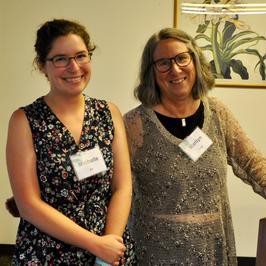
2017 EDGE Award Recipient
Michelle E. Zill, Ph.D. Candidate in Earth Sciences
Bioturbation’s Impact on the Deep-Sea Sediment Record During the Paleocene-Eocene Thermal Maximum
Our current climate is changing at a rapid pace, and one of the best ways to predict the future is to investigate the past. Current climate models are limited by a lack of the biogeochemical processes that obscure Earth's reaction to such a rapid release of carbon into the atmosphere, and thus fail to predict Earth's current system. As CO2 levels continue to increase in our atmosphere, a major concern is how ocean ecosystems will react to consequential warming. My research analyzes past events to answer this question, and focuses on major climate shifts throughout the Late Paleocene and Early Eocene, including events such as Paleocene-Eocene Thermal Maximum (PETM). I am currently working on a project which compares the biological and chemical responses of the Atlantic and Pacific basins, to quantify one of the great mysteries left in paleoceanography: the amount of carbon released during this extreme event.
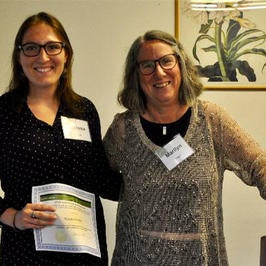
2017 EDGE Award Recipient
Marissa Giroux, Ph.D. Candidate in Environmental Science
How climate changes stressors such as increasing salinities and temperature affect smoltification and salmonid survival
The intrusion of saltwater into estuarine and fresh water environments due to rising oceans caused by climate change results in hypersaline waterways, such as in the San FranciscoBay-Delta. The increasing sea surface salinity is also due to a decrease in freshwater input from the drought. Organisms living in the estuaries are exposed to a higher salinity range, and this can cause increased stress. Endangered juvenile salmonid species, Steelhead trout (Oncorhynchus mykiss) and Chinook salmon (Oncorhynchus tshawytscha) inhabit the San Francisco Bay-Delta during the alevin, fry and parr stages and are exposed to the stress of premature hypersaline acclimation. Salmonid species undergo smoltification, the transition of fish from freshwater to saltwater, which involves significant physiological and morphological changes during this life stage. The first aim of my research is to better understand how climate change stressors, such as increasing salinities and temperatures, affect smoltification and salmonid survival.
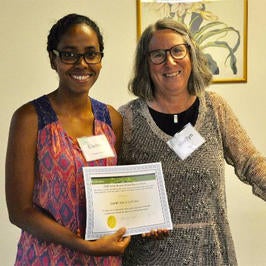
2017 EDGE Award Recipient
Eleinis Ávila-Lovera, Ph.D. Candidate in Evolution, Ecology & Organismal Biology
Do woody plants with photosynthetic stems respond differently to drought? An ecophysiological evaluation of tropical and subtropical ecosystems
Woody plants with green photosynthetic stems inhabit all the drylands of the world, including subtropical deserts in North America and tropical dry woodlands. Plants with photosynthetic stems are usually drought deciduous, so having green stems allows them to continue gaining carbon through the dry season of the year. With more frequent, severe and longer droughts, stem photosynthesis along with other drought survival traits seem to be a good strategy for plants to continue physiological activity during drought and ensure survival (Santiago et al. 2016). The main question I address in my dissertation is “do woody plants with photosynthetic stems respond differently to drought?” Plants with green stems are thought to have advantages that allow them to live and persist in the hot and dry ecosystems they inhabit, including 1) extra carbon gain, and 2) high photosynthetic water-use efficiency (WUE). There is a lot of evidence for the first advantage, but for the water-use efficiency hypothesis the data is more scarce. My research focuses on two aspects of this framework: 1) comparing leaves and green stems to see if established relationships among leaf traits hold for stems as well, in which case we can use our knowledge of leaf physiology to better understand stem physiology; and 2) comparing green-stemmed and non-green stemmed plants to find out if the advantages are real.

Leanne Hancock, Ph.D. Candidate in Earth Sciences
Reconstructing Past Marine Environmental Chemistry
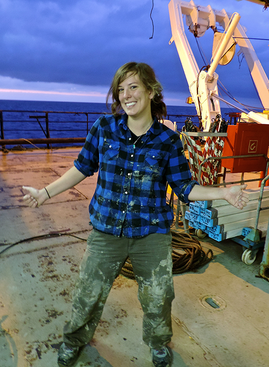
My name is Leanne Hancock, and I am a 5th year Ph.D. student in the Earth Sciences department at UCR. My research is focused on reconstructing past marine environmental chemistry in an attempt to understand and quantify evolutionary drivers and ecological interactions. My work more specifically focuses on marine methane cycling.
Methane is an extremely potent greenhouse gas that has played a major role in much of Earth’s climatic history. Since methane is a gas, it is not readily preserved in the rock record. We are therefore forced to look at other chemical species that interact with methane that do get preserved.
I have quantified the relationships between sulfur and methane in the modern time period as a function of methane fluxes in marine systems in hopes that sulfur compositions of rocks can be used as a proxy for understanding methane’s presence and importance in the past.
One environment in which methane is very important is in cold seeps. Cold or hydrocarbon seeps are places on the seafloor where methane and other gases are diffusing out of the sediment into seawater. The chemicals in these fluids are capable of sustaining a unique and diverse community of organisms that do not require energy from sunlight to survive. These environments and the organisms that thrive there are thought to have evolved very early in Earth’s history. They are also thought to have been places of refuge for marine organisms during mass extinctions, as they are isolated from surface conditions.
I am interested in understanding the production of the methane and sulfide that these systems require and how the cycling of these components might control the distribution of organisms found at these sites throughout time.
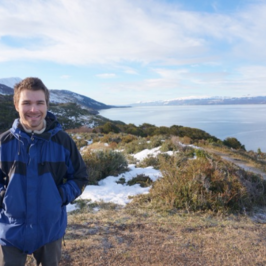
Graduate Student Jon Nye's Research in Patagonia, Argentina
At the intersection between the Atlantic, Pacific and Southern oceans, Tierra del Fuego and the Beagle Channel are physical and biological nexus points that are poised to be highly influenced by climate change. Such changes can alter the function and significance of species within an ecosystem. One way to identify effects of climate and human activity on an ecosystem is by comparing Holocene and historic food webs, by measuring changes in food chain length and fluctuation in species’ niche and population. Graduate student Jonathan Nye aims to address three primary questions: (1) How has the marine ecosystem near Tierra del Fuego changed over time, (2) How have humans influenced and been influenced by changes in this ecosystem and (3) What are the characteristics and changes in population of Southern Fur seals in the Holocene? Check out his blog.

